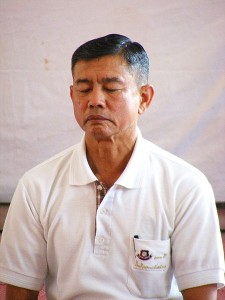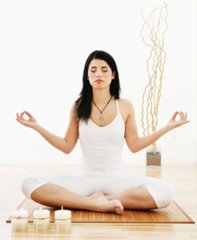Author Archive
 Body Awareness Meditation Script
Body Awareness Meditation Script
Begin this body awareness meditation by assuming your usual position for meditation. Once you are settled and comfortable close your eyes and take a few deep breaths through your nose. If you have a blocked up nose it is fine to use your mouth.
Focus on the sensations that you breathing offers. The way the air feels cool as you inhale and warm as you exhale, how your stomach expands as it draws in oxygen, the energy that this oxygen provides your body.
If you find your mind wandering at any time away from your focus do not chastise yourself, just allow yourself to refocus on your breathing.
When you feel ready begin to shift your focus from your breathing to your body in general. If you feel any aches, pains or stiffness loosen these parts of your body until you feel as comfortable and natural as possible.
Now it is time to start focusing on individual parts of the body, beginning with the feet. As you focus on specific parts of your body you may find that they begin to feel warmer and more relaxed. Imagine that your feet are the roots of your body, drawing awareness up from the ground up into the rest of the body.
Allow this awareness to spread up through your feet to your ankles and lower legs. Enjoy the relaxed warm feeling. Experience how your lower legs seem to feel much heavier and looser than normal. Now allow this awareness to spread to your knee joints. If you have problems with your knees (or any other part of your body) you may use this time meditation to visualize your body healing itself as you go from point to point. 
Slowly let your awareness spread further up to the upper legs, hips, buttock and genitals. Many people find that they hold much of their tension in these areas so spend a little extra time allowing these parts of your body to relax and loosen, letting the energy and awareness course through.
When it feels right draw this energy and awareness to the base of your spine. It is important not to rush through meditation as you will find your muscles will tense up which will impair your efforts considerably.
Focus this awareness up through the curvature of your spine to the tip of the spine which is about an inch below the knuckle-like bump in the back of your skull. Relax and ease the muscles around this point, this will include loosening your jaw if you haven’t already done so.
Once you have a feel for this top point of your spine keep it in your mind whilst also focusing on the base of your spine. Imagine a warm ball of light at both the top and bottom of your spine. The light at the base of your spine is slowly drawn down into the ground below you like a loving anchor. The light at the top of your spine is slowly moving up towards the heavens. You will find that the muscles that hold your spine begin to loosen and each vertebra of your spine create a little extra space between each other.
When your spine is fully relaxed shift your focus to you shoulders. You may find that you need to now readjust the position of your shoulders to remain comfortable now that your spine is so well relaxed. Experiment with moving them gently into different positions until they feel in synch with the rest of your posture. Draw this awareness down your arms and into the fingers. Notice the very slight movements they are making all on their own.
Move your awareness back up to your throat and release any tension that you may be holding there before moving further up to your face. Feel the warmth of your awareness relax every facial muscle. Notice how sensitive your face is, how the air feels against it.
Finally shift your awareness to your brain. Become aware of just how amazing and powerful your brain is. Your brain is capable of regulating your entire body. Your brain houses your mind which allows you to think, feel and create.
When you feel ready open your eyes and return to waking consciousness.
 Meditation Shown To Help Reduce Pain
Meditation Shown To Help Reduce Pain
A recent study published in the April 6 2011 edition of the ‘Journal of Neuroscience’ shows that meditation can have a very significant pain reducing effect on the brain.
15 volunteers who had never meditated before were given four twenty-minute meditation classes. Before and after this training, the volunteers brain activity was examined using a special type of imaging, called arterial spin labeling magnetic resonance imaging (ASL MRI). During these scans, a heat device was placed on the volunteers legs in order to induce pain. 
The scans taken after meditation training showed that all 15 volunteers pain ratings was reduced. Decreases ranged from 11 to a massive 93 percent.
“This is the first study to show that only a little over an hour of meditation training can dramatically reduce both the experience of pain and pain-related brain activation,” said Fadel Zeidan, Ph.D., the lead author of the study at Wake Forest Baptist Medical Center.
“Meditation produced a greater reduction in pain than even morphine or other pain-relieving drugs, which typically reduce pain ratings by about 25 percent.”
This study also showed that meditation significantly reduced brain activity in the primary somatosensory cortex, an area that is heavily involved in creating feelings of where and how intense a pain is. The scans taken before meditation training showed high activity in this area, but when the volunteers were meditating, activity in this region could not be detected.
The research also showed that meditation increased brain activity in other areas such as the anterior cingulate cortex, anterior insula and the orbito-frontal cortex.
“One of the reasons that meditation may have been so effective in blocking pain was that it did not work at just one place in the brain, but instead reduced pain at multiple levels of processing.”
This is exciting news as many pain relieving drugs contain negative side effects which can hamper a patients recovery. There is now a proven drug free alternative that has no negative side effects. Meditation only has the positive side effects of increased health, happiness and relaxation. Just one hour of meditation training made all the difference, which shows how incredibly accessible meditation really is.
This shows that you don’t need to be some sort of meditation guru with decades of experience to make a positive impact into your life. However it is likely that with even more experience, even greater results can be achieved.
—
Thank you to Jon Rhodes DHyp of HypnoBusters Hypnosis and Gastric Band Hypnotherapy for providing us with the article above.
 What Does Meditation Feel Like?
What Does Meditation Feel Like?
Answering this question can be difficult as there are many different meditation techniques which result in varying sensations. Also the same form of meditation can result in a different experience for different people.
Generally though meditation is a deeply relaxing experience. Your sense of self-awareness will become much greater, if you’re performing a meditation focusing on you body for example you will be able to think your way around your body and “warm” the area you are focusing on. When you meditate you are very much “in the moment”. If you’ve ever played sports at a competitive level there may have been times when you felt so focused that you were only aware of the actions your were performing (commonly known as being “in the zone”) – meditation is very much like this only your focus is internal.
The feeling of meditation doesn’t end after your session does. You will find with regular meditation that you feel a lot less anxious and more peaceful than before. Many people also find themselves becoming much more accepting of their own flaws as well as those of people they know.